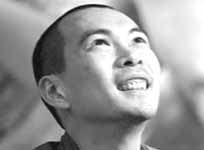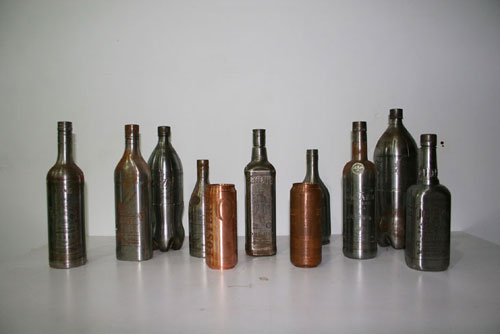



Zheng Guogu was born on 1970 in Yangjiang, Guangdong
province, China. He lives and works in Yangjiang, Guangdong province, China.
Zheng Guogu is one among a growing number of postmodern artists who have been
reacting to the rapid shifts taking place in China over the past ten years by
giving artistic shape to the phases of social and economic transformation. What
distinguishes him is his commitment to the local culture of his hometown and his
role in directing attention to it, while engaging with trends in global
contemporary art. The international art world has fallen in love with
contemporary Chinese art, and somehow Zheng Guogu, although often included in
group exhibitions in Asia and Europe, has not been singled out often enough. He
juggles fact with fiction or myth, while controlling the entry points to his
community for visitors from the art world, who make the trek to visit him in the
small town where he lives and works. I went to visit Zheng Guogu in the fall of
2003 on my second research trip to China. Luckily, Lydia Thompson, a colleague
from San Diego, who has a Ph.D. in Chinese art history accompanied me, and since
she speaks Mandarin, was pressed into the role of translator. Zheng Guogu came
to pick us up from Guangzhou, China's largest city in the south, and brought us
to his hometown of Yangjiang, two hours drive away.
Zheng Guogu was born in 1970 in Yangjiang, towards the southwest part of
Guangdong province. Known for its knife and scissor factories, it is situated on
the edge of the China South Sea. Yangjiang became a town in 1988 when farmers
and others from the outlying rural areas were encouraged to move there to
participate in a new economic enterprise zone. Zheng Guogu comes from an
artistic family. His father is a traditional instrument maker and a singer, who
has at times worked for the Hong Kong Opera, a five hour drive east from
Yangjiang.
During the years that Zheng Guogu was growing up, things were already changing
in China as the Maoist period receded into the past and the country opened up to
the rest of the world. He and his generation had access to the West and Hong
Kong through television, pirated CVDs of Hollywood films and computer games. So
although he was physically isolated, he was accessing the West, albeit
virtually, at a young enough age so as to take these new experiences and
freedoms for granted. He attended the Guangdong Academy of Art in Guangzhou,
China's third culture capital, with a focus on printmaking.
While a student there, he was introduced to a slightly older group of artists
that formed the Big Tail Elephant Group (Lin Yilin, Chen Shaoxiong, Xu Tan and
Liang Juhui) in 1991, and they encouraged the younger artist to experiment with
performance and conceptual art.

Zheng Guogu

One of his famous artwork
2006 * Zheng Guogu Exhibition, Shanghai, China
2005 * Puzzle--It is from Yangjiang, Grace Alexander Contemporary Art Gallery, Switzerland
2004 * Zheng Guogu-My Home Is Your Museum, Vitamin Creative Space, Guangzhou, China
2003 * Photo works 1997-2000, ShanghART, Shanghai, China
2002 * Are You Going to Enjoy Calligraphy or Measure Blood Pressure? Shanghai (together with Sha Yeya, Chen Zaiyan, Sun Qinglin), China
2001
* Zheng Guogu--The Compressing World Yangjiang Guangdong, China
2000 * Zheng Guogu - More Dimensional Caaw, Beijing, China * Zheng Guogu - More Dimensional in Shanghai, BizArt Space, Shanghai, China
1998 * Sixteen of the Ten Thousand Customers and other Works Beijing Photo Gallery, Beijing, China
Conclusions: Zheng Guogu had already established his own style and the impact of the work had won him a strong reputation in Chinese art circles.
View
Zheng Guogu paintings, biography, solo exhibitions, group exhibitions and
resource of Zheng Guogu. View art online at The Saatchi Gallery - London
contemporary art gallery.
Zheng Guogu
